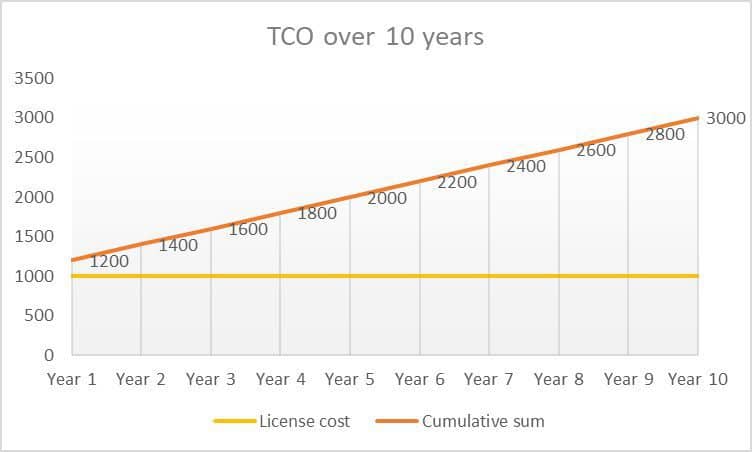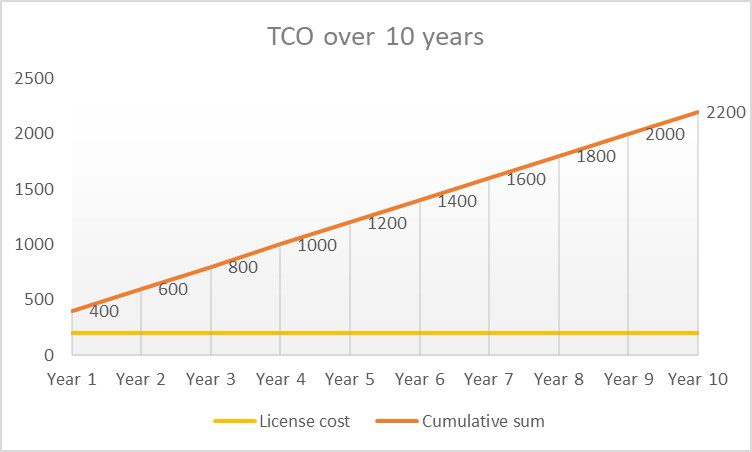From a legal point of view, the customer purchases a license to use software and can use it forever. However, software deteriorates over time just like a car does. It runs on the current operating system version, uses the current database version, is compatible with the current browser, etc. This creates an interesting situation where, on the one hand, something is bought to be used forever, but can only be used for a limited time. This is where the support contract comes in to keep the software up to date. This is okay – so long as the vendor still has interest in the product, that is.
Looking at the total cost of ownership (TCO) for ten years, assuming the license fee is 1,000 and the maintenance is 20 percent, after five years, there is a breakeven. The license costs of 1,000 is now equal to the cumulative support fees paid. Buying the software again would be equally expensive. This is obviously not a viable solution, but it shows the relationship between initial costs and maintenance costs. The shorter the expected lifetime of the software is, the more important the license fees.
Just to put this into perspective: SAP’s guidance for 2021 is 3.7bn USD in software licenses and 12bn in support fees. See SAP’s balance sheet or this dashboard for details. Not only is the support revenue three times higher, but the margin is likely high as well. The income statement of the year 2000, listing 2.3bn as software revenue and 1.6bn maintenance, shows a different relationship between the two segments.
Regardless, the real questions are: What is the value of support for the customer? What are the costs for the software vendor?
Value of support
What does the support contract provide?
- Support. Contacting the vendor and getting personal help.
- Bug fixes. If the product does not behave as it should, the software vendor will fix it.
- Maintenance. This includes everything that’s necessary to keep the software running on current platforms.
- Enhancements. Meaning optimizations of the current functionality to be more productive.
- New features. Larger changes to make the product more powerful.
Twenty years ago, the majority of the costs the vendor incurred for support was to pay the staff. Now, the customers mostly google the error message and get help either from a vendor’s public forum or other forums like stackoverflow. The customer gets an answer faster, usually at a higher quality, and can ask questions that go deeper into the topic. Best of all, for the vendor, many questions get answered by external people.
What used to make up 80 percent of the costs – cost of labor – is today more about 20 percent, if that. The support team gets downsized, and the department creates phenomenal margins.
All other costs are allocated to the development team. Especially the bug fixes are yet another interesting point in software contracts. One could argue that bug fixes must be provided for free, but all contracts exclude that: The software is provided as-is.
The maintenance costs are effectively zero, enhancements and new features are the biggest cost segments during the overall software lifecycle. Hence it should also be the biggest reason to pay the support fees. However, what if the vendor creates a new product, e.g., S/4 Hana as successor for R/3 and ERP/ECC 6.0?
Don’t be blinded by discounts
Looking at the total costs of ownership from this point of view shows the importance of looking into the contract details. As a customer, I would ask questions like:
- You claim that your response time is 24 hours, but what happens if, after the initial response of “We are looking into it” or “Did you upgrade to the latest version?”, no further response comes, even after weeks or months?
- Maintenance is guaranteed, but what if little further development happens, not even as new features or enhancements? When I buy the product, there might still be 100 developers assigned to it, but tomorrow, there might only be three developers working on it. What happens then?
Most important for support contracts is the definition the percentage is based on: The actual license costs or list price? If 1,000 was the list price and the customer got an 80 percent discount, but the support fee is based on the list price, the diagram now shows a different breakeven point – one year! It would be equally cheap to buy the software at 200 (80 percent discount of 1,000) every year instead of paying support fees of 200 (20 percent of list price). Obviously, it cannot be assumed the vendor provides the same discount every time the customer wants to buy, so this is not a viable solution. But it underscores the importance of looking at the support costs instead of being blindsided by license cost savings.
A pay-per-use license is obviously the best option for the customer. It creates the pressure to provide high-quality products, fix things fast, and to constantly add new functionality to be competitive. If a software vendor ignores just one of these areas, the customer might cancel their subscription. A subscription with a monthly termination option is a good indicator the vendor has trust in their offerings.


















![sap support [shutterstock: 366750500, pathdoc]](https://e3zine.com/wp-content/uploads/2021/11/sap-support-shutterstock_366750500.jpg)





Add Comment